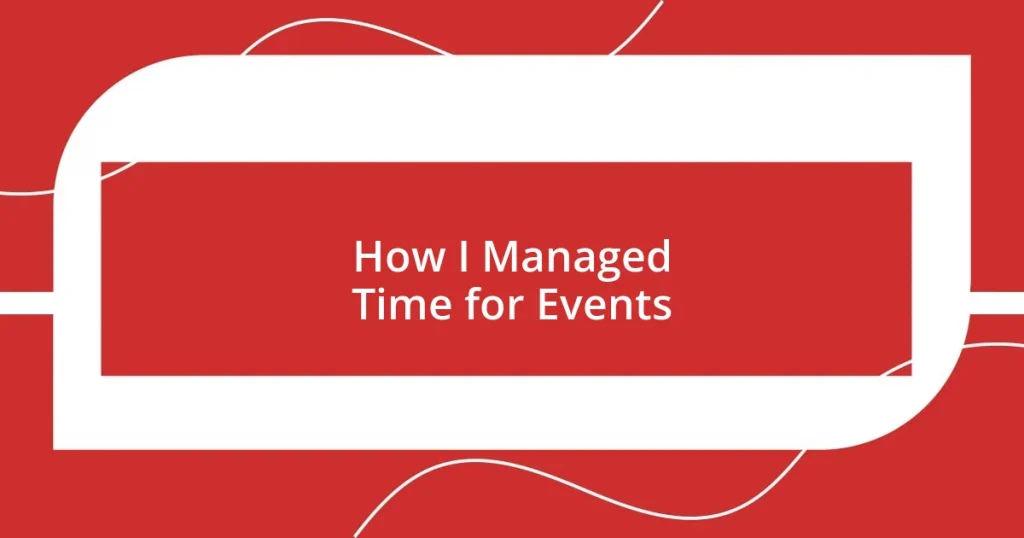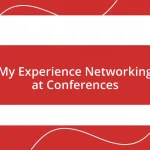Key takeaways:
- Identify events that align with personal and professional goals to maximize growth and networking opportunities.
- Create a prioritized event calendar to focus on relevant events while remaining flexible to adapt to changing circumstances.
- Set boundaries to manage commitments effectively, ensuring time is spent on valuable and energizing experiences.
- Implement continuous improvement strategies by reflecting on past events and seeking feedback for better future planning.

Identifying Key Events to Attend
When I look for key events to attend, I often start by reflecting on my personal and professional goals. For instance, there was a conference last year focused on digital marketing that aligned perfectly with my career aspirations. Attending it not only expanded my knowledge but also helped me connect with industry leaders—something I hadn’t anticipated would have such a profound impact.
I also like to think about the value each event brings to my life. Is the event going to inspire me or educate me? I recall a local art fair that seemed small but turned out to be a treasure trove of ideas and networking opportunities. It’s these unexpected gems that often make the most significant difference in our journey.
Moreover, I frequently assess the alignment of the event’s theme with my interests. For example, I once hesitated about attending a wellness retreat, thinking it wasn’t for me. But once there, I discovered practices that transformed how I manage stress, changing my perspective entirely. What events have you overlooked that might surprise you?

Creating a Prioritized Event Calendar
Creating a prioritized event calendar is crucial for effective time management. I remember a time when my calendar was chaotic, filled with events I thought I should attend, but didn’t genuinely resonate with my goals. After reevaluating my approach, I decided to categorize events based on their relevance to my professional and personal growth. This simple shift made a world of difference, allowing me to focus on the experiences that truly mattered.
When I prioritize events, I consider the opportunities for learning and networking. For instance, I once had to choose between two conferences scheduled on the same weekend. One was a larger event with renowned speakers, while the other was a smaller, niche gathering. I took a step back and realized that the smaller event was tailor-made for my specific interests. Choosing it not only deepened my knowledge but also led to valuable connections with individuals who are now close collaborators.
Creating an event calendar also involves flexibility. Life is unpredictable, and priorities can shift. For example, there was an intriguing workshop on public speaking that I nearly missed because of an unexpected work commitment. By staying adaptable and reassessing my calendar, I managed to fit it in, and it turned out to be a game-changer in building my confidence. Have you ever had to scramble to adjust your plans? It’s all part of the journey in managing time effectively.
| Criteria | Example 1 (Conference) | Example 2 (Workshop) |
|---|---|---|
| Relevance to Goals | High | Medium |
| Networking Opportunities | Numerous | Limited |
| Personal Interest | Low | High |
| Potential for Growth | High | Moderate |

Setting Boundaries for Event Participation
Setting boundaries around event participation is essential for effective time management. I’ve learned, through trial and error, that it’s easy to overcommit, especially when invites start pouring in. There was a time when I felt torn between attending a friend’s birthday party and an important seminar. I realized that by fostering boundaries, I could make more intentional choices that align with my values. It’s about saying “yes” to the right events while graciously declining those that don’t serve a purpose in my journey.
To help set these boundaries, I’ve found it useful to consider the following points:
- Evaluate your commitments: Determine which events align with your goals and which don’t.
- Communicate your limits: Let friends and colleagues know your availability to avoid feeling pressured.
- Prioritize self-care: Recognize when you need downtime to recharge, even if it means missing an event.
- Reflect on past experiences: Analyze how certain events made you feel. Was it energizing or draining?
- Be selective with social obligations: Choose social events that genuinely excite you rather than those you feel obligated to attend.
By incorporating these strategies, I not only safeguard my time but also enrich my experiences when I do choose to participate. Each decision becomes clearer, allowing me to invest my energy in what truly brings me joy and growth.

Using Tools for Time Tracking
Using time tracking tools has truly transformed my ability to manage events effectively. When I first delved into tools like Toggl and Trello, I was astounded by how these platforms could provide a clearer view of where my time was going. By breaking down each task related to an event—like planning, logistics, and follow-ups—I could see where I was spending too much time and where I could streamline my efforts.
One particularly busy season, I decided to use a Pomodoro timer app while preparing for an upcoming event. I’d heard about the technique of working in short bursts with breaks in between, but actually tracking my time changed everything. With focused 25-minute sessions, I found I was much more productive. It was eye-opening to realize that I often wasted time scrolling through social media instead of diving into preparation. Have you ever counted how much time you spend on distractions? I started to track these moments too, and it was a game-changer.
Additionally, I leaned into calendar tools like Google Calendar to keep all my events organized in one place. At first, it felt a bit overwhelming, but the ability to receive reminders made a world of difference. I remember almost missing an important preparatory meeting simply because it slipped my mind. Now, I set alerts not just for the event itself but also for any crucial planning sessions leading up to it. It’s incredible how these tools can keep me accountable, ensuring I never miss out on opportunities that could impact my journey.

Evaluating Time Spent on Events
Evaluating the time spent on events has been a real eye-opener for me. I recall a time when I overscheduled myself for weekend gatherings, thinking I could squeeze in social interactions without impacting my week. But, by Sunday night, I often felt drained instead of fulfilled. It prompted me to ask myself, “What am I truly gaining from this?” This reflection led me to evaluate each commitment more critically, ensuring they matched my values and energy levels.
After embracing a more evaluative approach, I started to keep a simple journal where I noted the feelings and outcomes of each event I attended. I was surprised to find that some gatherings left me inspired and energized, while others felt like a chore. This practice not only helped me recognize patterns but also made it easier to prioritize future engagements. Have you ever thought about how some experiences can invigorate you while others might sap your energy? By closely analyzing these feelings, I began to prioritize events that aligned with my passions.
I also engaged in regular self-reflection after each event, asking, “Did this experience contribute positively to my life?” This question often reveals surprising insights. I remember attending a networking event that initially felt like a waste of time; however, one meaningful conversation shifted my perspective entirely. From that moment, I made it a habit to consider not just the quantity of events but the quality of experiences they provide. Each reflection became a stepping stone toward more intentional participation in events that truly matter to me.

Implementing Continuous Improvement Strategies
Implementing continuous improvement strategies in my event management approach has become essential over time. I remember a time after a particularly hectic event when I felt I could have done things differently. I took the time to dissect the entire process, identifying bottlenecks in my workflow, and realized that my communication with vendors was often rushed and unclear. This insight led me to establish a standard set of templates for emails and checklists, dramatically reducing misunderstandings and streamlining collaboration.
One practical strategy I adopted was the “after-action review” after each event. It’s a straightforward concept: sitting down and openly discussing what worked, what didn’t, and what could be improved next time. I recall a debriefing session with my team where we discovered that we had underestimated the time required for setup. This honest conversation resulted in changing our planning timelines and, as a result, our next event ran smoothly with less stress. How often do we take the time to reflect on our processes? This practice not only fosters transparency but also ignites a proactive mindset for future projects.
Engaging in continuous improvement also means embracing feedback—not just from my team but from attendees. I started sending out anonymous surveys after events, asking for specific insights on what people enjoyed and what could be enhanced. Initially, I felt apprehensive about this feedback; what if the responses were negative? Yet, this openness led to invaluable suggestions that directly influenced how I approached my events. For instance, a simple comment about providing better signage improved navigation for guests in subsequent gatherings. It’s fascinating how a little willingness to listen can generate significant improvements.















